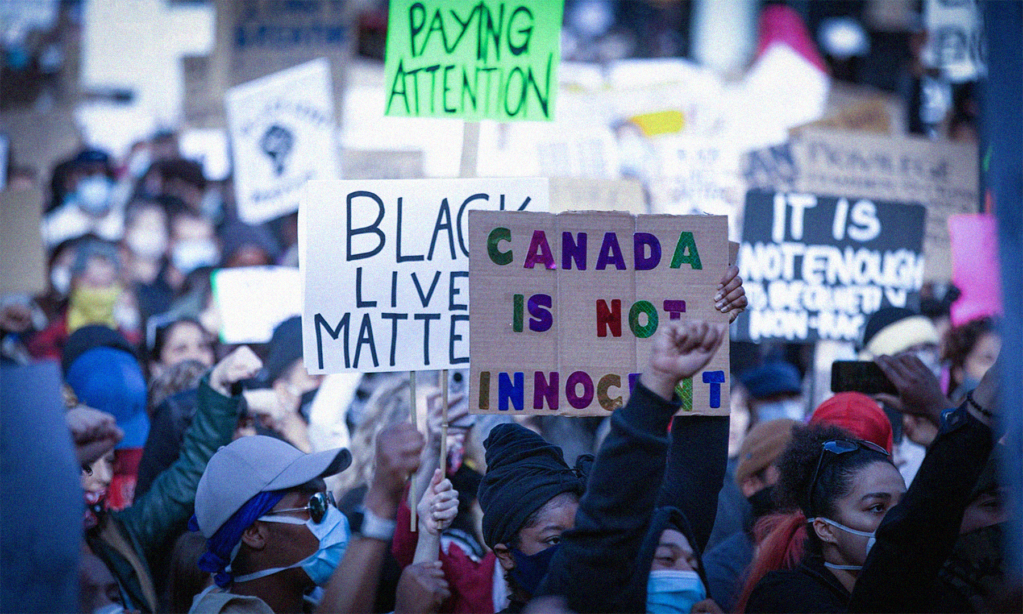One hundred years ago—July 1, 1923—the Canadian government passed “An Act Respecting Chinese Immigration.” Known as the Chinese Exclusion Act, it was an overtly racist law prohibiting the arrival of newcomers from China. It also required all people of Chinese heritage, including the Canadian-born, to register with the federal government in order to stay in the country. Chinese Canadian communities across the country mobilized to lobby against the act but in the end their efforts failed to stop its passage. Thus, July 1 came to be known as “Humiliation Day” for many Chinese Canadians.
On the 100-year anniversary of the passing of the Chinese Exclusion Act, The Monitor is releasing a series analysing the context in which the Act passed, resistance to the law, and its historical legacy. These articles are a serialization of the booklet 1923: Challenging Racism Past & Present, which you can read in full at https://challengingracism.ca/
Much has changed since 1923. Or has it?
After World War II, the Canadian state entered a period of liberal reform. Indigenous, Black, other racialized communities, women, labour, and LGBTQ2S communities made important social, economic, and legal gains, often at great personal, physical, and emotional cost. These gains included the repudiation of the Chinese Exclusion Act, voting rights for racialized peoples, legal victories for Indigenous peoples, the end of overtly racist immigration laws, and improved civil and labour rights.
These steps provided footholds for ongoing challenges to racisms that were continuously adapting, retaining the power to racialize, exclude, and impact specific groups. Thus, beneath a veneer of equality and adherence to multiculturalism, there evolved a “tangled, often- invisible web of prejudice that make up what we call systemic racism. This web includes the social standards against whom all are judged and usually reflects a normative white settler experience, affording those of European heritage the perennial advantage of white privilege.”
Systemic racism affects many parts of Canadian society. Deeply embedded within institutions, latent or ambient racisms constantly produce micro-aggressive reminders of who is “in”, and who is “out”. People in anti-racist or decolonizing movements regularly encounter this web of racism – at times as invisible but real walls of apathy or inertia, or in active resistance to change within organizations.
Moreover, overt forms of white supremacy also persisted – the racist murder of Nirmat Singh Gill at the Guru Nanak Sikh Gurdwara in Surrey in 1998 being a case in point. Today, we recognize the Missing and Murdered Indigenous Women and Girls, and police violence against Indigenous, Black, and other racialized communities as overt, institutionalized forms of white supremacy.
However, ongoing Indigenous resistance, anti- racism, and other progressive social movements have continuously mobilized for systemic change. In 2020, a global anti-racist uprising occurred. In Canada, First Nations mobilized against environmental racism and demanded land back; a vibrant Black Lives Matter movement erupted against police violence; and new social groups contested anti-Asian racisms related to the COVID-19 pandemic.
Building on a decade of Indigenous resurgence that emerged with Idle No More in 2011, this uprising pointed towards the end of Canada as a settler colony. Reflecting generational changes, new demographics, and innovations in education, a new social mood encouraged not only redress for past injustices, but a revisioning of our collective future.
A New Backlash?
We worry, however, that we are currently witnessing a change in momentum, a conservative shift that could turn into an organized backlash against racialized communities and social movements. Such a backlash would turn back the clock and could instigate another era of repression and reaction, just as the backlash in the 1920s marked the onset of two hard decades.
One sign of this shift was the so-called “Freedom Convoy” of January 2022 that illegally occupied downtown Ottawa for weeks. Abetted by police, this protest attracted a wide assortment of supporters yet seemed firmly rooted in notions of white supremacy. Many of the leaders of the convoy, including Tamara Lich, B.J. Dichter, and Pat King identify with white nationalist movements. King had advocated the ‘great replacement theory’ that harkens back to 1920s tracts such as The Writing on the Wall. The racism appeared in the double standard enforcing the law – handling the mainly white demonstrators in Ottawa with kid gloves while using undue and often deadly force against land defenders and environmental activists.
Across Canada, racialized communities felt targeted by local demonstrations in support of the convoy. When Selam Debs, an anti-racist educator in Waterloo, posted criticism of the “Freedom Convoy” on Twitter, she was swamped with hate mail and racist posts. Often buried under a veneer of Canadian politeness, the racism and hatred associated with white nationalism quickly surfaces when challenged.
Unfortunately, populist politicians are continuing to fan these flames, embracing or encouraging white nationalism in the hope of stirring up a conservative backlash. Instances of anti-gay/trans attacks are increasing, and we are frequently hearing “anti-woke” tirades, not dissimilar to what is happening in the United States. Is this the onset of a conservative shift, intersecting with persistent currents of racism?
Increasing Sinophobia
Since the arrival of newcomers from China, white settler’s racial anxieties generated a stream of “yellow peril” narratives that led to serious exclusions beginning in 1872 when Chinese Canadians and First Nations were denied the right to vote. Today, we are seeing a revival of anti-Chinese racisms.
New racist narratives have accompanied the economic rise of China, welcomed with one hand yet labelled a threat on the other. This exploded into a full-blow crisis with Canada’s detention of Meng Wanzhou and the arrest of Michael Kovrig and Michael Spavor by China, amplified by the anti-Chinese racisms arising out of the COVID-19 pandemic.
Though the pandemic receded, racism related to China and Chinese Canadians has accelerated, this phase marked by accusations of Chinese interference in Canada. Much of this current panic has been stimulated by CSIS, focusing its fire against China, aided by convenient leaks to conservative media. This has produced a dangerous hysteria gripping Canada.
Sinophobia today is rampant, yet not easily challenged. Justifiable criticisms of the Chinese state may be overstated, supporting the CSIS-inspired notion that China is a threat to Canada, and inflaming divisions among communities. Unfortunately, the opposition parties in parliament have seized on this issue for political gain, forcing the resignation of David Johnston, the former governor-general of Canada. Will this in retrospect mark another tipping point towards calamity?
Persisting Islamophobia
In January 2017, Alexandra Bissonnette murdered Khaled Belkacemi, Azzeddine Soufiane, Aboubaker Thabti, Mamadou Tanou Barry, Abdelkrim Hassane, and Ibrahima Barry and wounded five others at the Islamic Cultural Centre of Quebec City. The perpetrator was an avid follower white nationalists.
Four years later Nathaniel Veltman drove to London, Ontario and used his bull-bar equipped truck to mow down the Afzaal family- murdering Salman Afzaal, Madiha Salman, their daughter Yumna and her grandmother, Talat Afzaal. Their son, Fayez, was seriously injured. This was also a premeditated act on the part of a white supremacist.
Though the “war on terror” that inspired Islamophobia has receded, the attacks on Muslims have intensified. Why?
Islamophobia gained traction in Canada after the 9/11 episode in 2001 that prompted the US-led “war on terror”. Islamophobia, the racist targeting of Muslims, became an essential aspect of the campaign. Maher Arar would be among the first casualties, but the list is long and unending.
The “war on terror” has led to the continual reinforcement of repressive state agencies such as the Canadian Security Intelligence Service (CSIS). Rife with Islamophobia itself, it has harassed Muslim or Arab communities, including Palestinian activists. A reinforced CSIS has now found additional targets, fanning the flames of Sinophobia.
Uniting for a Better World
In February 2023, R&B star Jully Black sang Canada’s national anthem at the NBA All-Star game. In her rendition she changed one word – instead of “O Canada! Our home and native land!” she sang “O Canada! Our home on native land.” Her version, recognizing Canada as Indigenous territory, went viral. It resulted in a racist backlash and accusations of disloyalty but also an outpouring of support. Jully Black’s action points how communities can come together through the recognition of Indigenous sovereignty.
Meeting the real threats to Canada and the world, the existential crises of environmental destruction, global pandemics, and the threat of global war demands innovative approaches to reimagining a collective future. Indigenous peoples offer important alternatives at this crucial time.
Fifty years ago, the Indigenous leader George Manuel began to outline a radical new relationship between humans and the earth based on his experiences in the Indigenous world: “This is not the land that can be speculated, bought, sold, mortgaged, claimed by one state, surrendered or counter-claimed by another.” It was the “land from which our culture springs […] like the water and the air, one and indivisible. The land is our Mother Earth. The animals who grow on that land are our spiritual brothers.”
Environmental Racism
The inability of the state to recognize Indigenous sovereignty and reorganize society based on that recognition is perpetuating the dispossession and oppression of Indigenous peoples. This takes many forms. In the context of current climate disasters, however, environmental racism is especially acute.
As the forests burn and flood waters ascend, Indigenous peoples and rural communities are once again hit the hardest. This reflects the continuous downloading of the negative effects of industrialization onto Indigenous and racialized communities. The fact that Canada’s economy is rooted in lands stolen from Indigenous peoples makes environmental racism particularly virulent.
Rather than find remedies, however, the liberal state feeds racial capitalism’s addiction to fossil fuels and resource extraction. It provides subsidies to pipelines or provides RCMP services to attack land defenders or those protecting old-growth forests. Today, smoke engulfs cities everywhere, a reminder that, in the end, environmental racism imperils us all.
Summing up his perspective on the past, he concluded: “The struggle of the past four centuries has been between these two ideas of land.” Many Indigenous communities embrace this philosophy and others are also building unique alliances in the same direction.
Today, activists such as Ingrid Waldron (McMaster University) have worked to bring Indigenous and Black communities together to confront environmental racism and racial capitalism as depicted in her book and movie There’s Something in the Water: Environmental Racism in Indigenous and Black Communities. Rinaldo Walcott, author of Black Like Who? also promotes the need for radical change. In his recent On Property, he connects the movement for prison abolition to private property, and advocates for a return to communal relations inspired by Indigenous notions connecting the land and its living beings.
These are the messages that can inspire social movements to come together and create the unity necessary to stave off a conservative backlash and re- imagine a better world, locally and globally.







